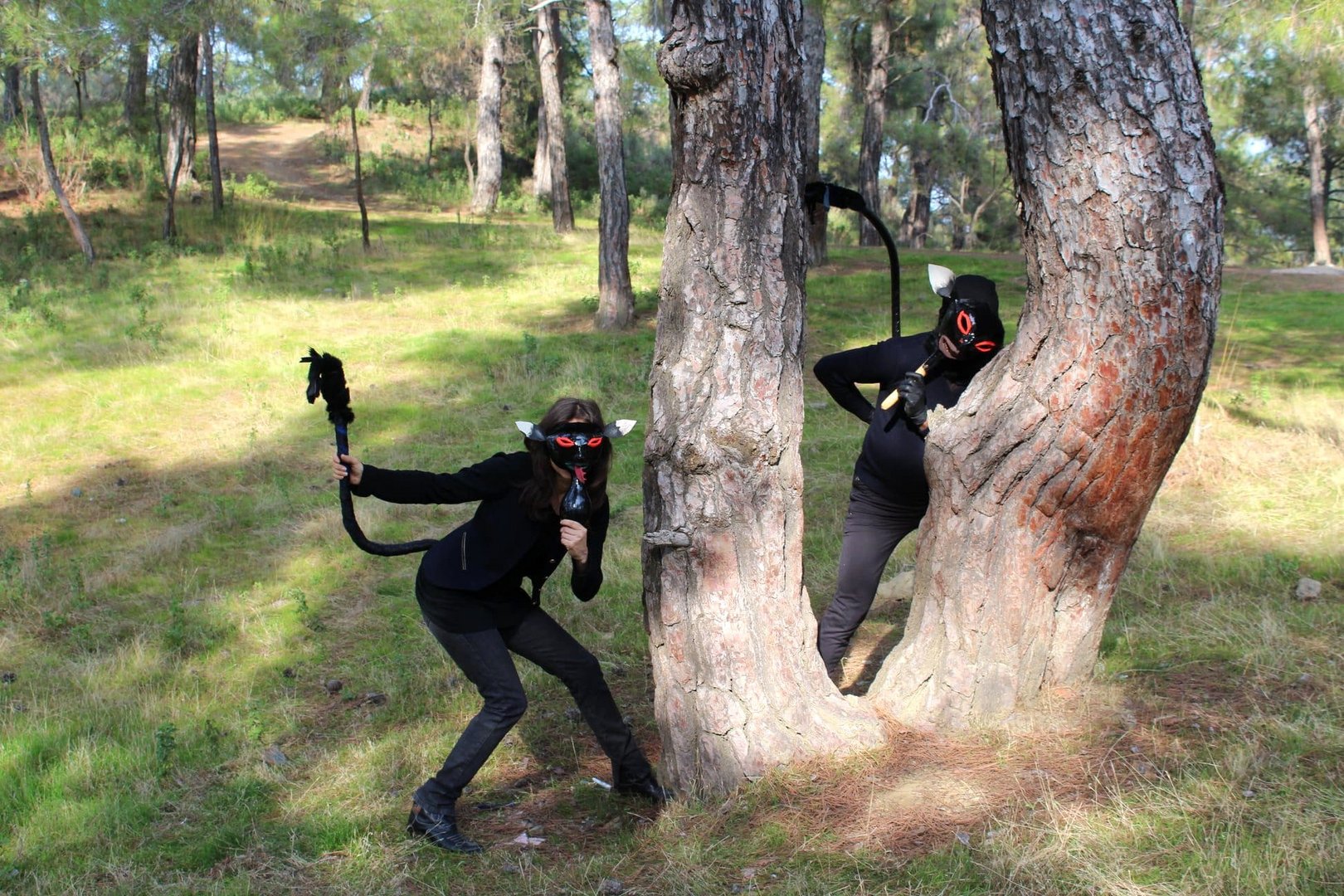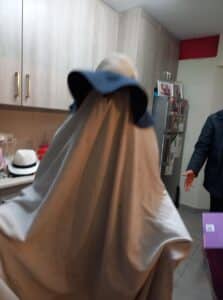The wearing of ritual or decorative masks in performances or ceremonies to hide the identity of the wearer
By Martin Clark
My articles in the Cyprus Mail usually deal with nature and the environment. Of course, the road to a better environment and greater nature conservation is not just about caring for wildlife or not dropping litter; it’s about sustainable lifestyles. To measure how we’re doing on a household, family, village, town or business level, we use the four pillars of sustainability: environmental, cultural, social and economical. All pillars are necessary to restore our battered planet and still beautiful Cyprus. Respecting and learning from our ancestors (who were more sustainable than we are) is crucial. Local village culture is important and reviving the masking culture of our ancestors, with integrity, scores well on each of the pillars!
When I refer to ‘masking’, I’m not talking about those wretched Covid face masks, or even smearing mud on our faces and placing cucumber slices over our eyes! I’m talking about the wearing of ritual or decorative masks in performances or ceremonies, even just to hide the identity of the wearer. I’ve collected such masks for about 40 years and my huge collection now resides in Slovakia in the beautiful village of Lišov, in the south central part of that wonderful country. (https://www.facebook.com/lisovmuzeum.sk/).
About 10 years ago, I was searching for a venue to establish a museum and I considered Cyprus. I mentioned this on social media and several Cypriots told me that there is no masking culture here. This is not true, but it is necessary to dig deep! The history of Cyprus is very complex but mask wearing actually goes right back, almost to the start of that history.
Why do I write about this now? Well culture and nature go hand-in-hand; those local festivals were fun, full of integrity but also environmentally, as well as culturally sustainable. In celebration of ‘localness’ from May 2022, we hosted a project ‘SCHISM’ (Shared Cultural Heritage in Secular Masking) in Pano Lefkara, with guests from Romania, Bulgaria, Greece, Germany and Slovenia (where the masking culture is very strong).
There were Mesolithic – pre-farming hunter gatherers, 11,000+ years ago – people in Cyprus but because they were nomadic, we know little about them; they were certainly fishing, gathering seafood and even hunting pygmy hippos and elephants (evidence from Aetokremnos near Limassol). In other parts of Europe and very likely in Africa and Asia, people of this period were mask wearers but there is no evidence in Cyprus, though it’s fun to imagine hunters with hippo and elephant masks!
The Neolithic period, saw the first farmers who lived in villages of roundhouses and were pretty advanced; they were early producers of painted pottery, even pre-pottery stone vessels are relatively common. They also grew cereals, domesticated wild mouflon and had sheep, goats, pigs, dogs and cats (even before the Egyptians domesticated cats). They were likely to have been ancestor worshippers because they buried their dead under the floor in their roundhouses. Certainly there was an influx of people from the mainland and they brought animals with them. They are synonymous and maybe related to the Vinča people in nowadays Bulgaria, Romania and Serbia (9,000 to 6,500 years ago); DNA studies are ongoing.
Certainly Cypriot art of this period and Vinča art share common characteristics, stumpy armed idols with tipped bag faces with regular features identify them as mask wearers. The evidence is much more in Romania and Bulgaria but in the late Neolithic there are good examples here in Cyprus. The Vinča statuettes/idols were women, leading to the idea of a matriarchal society with female shamans. From the end of the Neolithic and into the Copper Age (6,500 to 4,500 years ago), the masking culture of Cyprus seems to have blossomed and the Bronze Age (4,500 to 3,500 years ago) saw ritual use of animal masks, seen on stone and ceramic statuettes.
The masking legacy of the late Neolithic and early Bronze Age, developed more with the arrival of the Achaean Greeks around 3,200 years ago, introducing their language, religion and customs to the island, including the Greek mythology and the masks attached to it, such as Apollo, Demeter and Poseidon (bull).
Cyprus was subsequently colonised by the Phoenicians, Assyrians, Egyptians and Persians, all with some sort of masking culture. Around 2,300 years ago, the Ptolemaic dynasty (a legacy of Alexander the Great) took control of Cyprus and the masking culture changed again.
With the arrival of Catholics from the west, first with the Crusaders, then the Franks and finally the Venetians, the Roman idea of ‘carnival’ first appeared. The word came from the Latin words carnis (meat) and levare (to leave off), because straight after the carnival came Lent – 40 days of sacrifice. Latin carnivals ended on Shrove Tuesday (also called Mardi Gras in Latin, or Fat Tuesday in some countries) the day before Lent officially begins, which is known as Ash Wednesday. The carnival in Limassol is well known and owes its origin to the Latin rulers of Cyprus.
The original Dionysian Greek and later Roman masking festivals are still found in northern Greece, some Greek islands, Bulgaria, Romania, Slovenia, Sardinia, Spain, Portugal, Slovakia and Hungary; they are characterised by sheepskin clothing, grotesque masks and wearing belts of cowbells. For me it is very interesting that this culture disappeared early from Cyprus, and I think the reason is the very early adoption of Christianity with some churches being nearly 2,000 years old.
The most interesting Cypriot masking culture in Cyprus is the vernacular (ordinary village based) example of disguising masks on the eve of Green Monday. The practice is still linked to Lent but without the glitzy globalisation of the Latin style carnivals. Around 60 years ago, all villagers probably took part dressing up and covering their faces with sheets and hats and calling on friends and neighbours around the village to pass on good luck. The idea was to guess the identity of the disguised character; if you could not guess, you gave a reward. I would love to gather images from these local village festivities.
Also having more cultural integrity was the arrival of Turkish-masking culture with the Ottomans. The gourd mask seems to have been established with them and such masks are still common in Turkey. The ‘kallikantzaroi’ winter goblins are also pre-Christian and are an example of a cultural phenomena shared by Cyprus (Greek and Turkish Cypriots), Greece, Serbia, Bulgaria and Turkey; we could call it a Balkanic tradition.
In Lefkara and Kato Drys we revive the gourd mask making tradition to make individual kallikantzaros masks each Christmas to Epiphany when kallikantzaroi were traditionally thought to appear on people’s roofs to terrify the inhabitants.
Martin Clark has just published a video on the kallikantzaroi project: https://www.facebook.com/martin.d.clark.7/videos/1339114133501164
A professional forester and land manager, he is director of Grampus Heritage & Training, the UK’s most successful EU wide vocational training organisation, with 26 years’ experience











Click here to change your cookie preferences